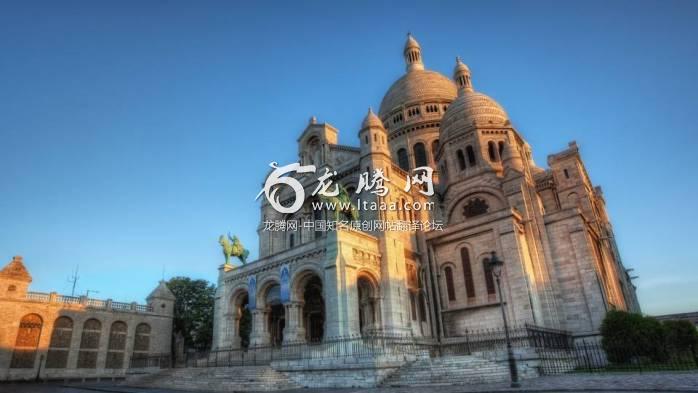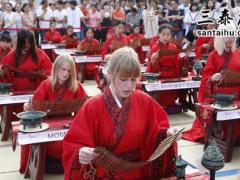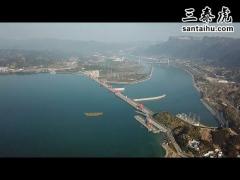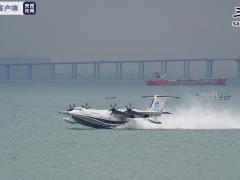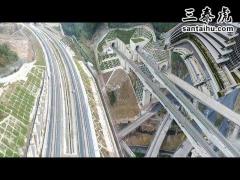我听说过日本和欧洲城堡,中国有类似的东西吗?(上) [美国媒体]
quora网友:我不知道你在说啥。难道你没有听说过紫禁城?它基本上是城堡之母!即使你突破了外围的防守,你依然处于外城。内城由一系列的城墙,大门和守卫分隔开。这基本上是如今你所能找到的最大的城堡。但它不是中国最大的城堡。这一荣誉要归于大明宫,据考古学家说法,大明宫是紫禁城的4.5倍.......
I hear about Japanese and European castles, but did the Chinese have anything similar?
我听说过日本和欧洲城堡,中国有类似的东西吗?
James Chao, Student of Chinese history.
I have no idea what you are talking about. Have you never heard of the Forbidden City? It is basically the mother of all castles!
我不知道你在说啥。难道你没有听说过紫禁城?它基本上是城堡之母!
It has a 52-meter wide moat, 10-meter high walls all around, a watchtower at each corner, and heavily guarded gates.
它有52米宽的护城河,10高的围墙,每个角落都有一个了望塔,还有重兵把守的城门。
And even after you breach the outer defense, you are still only in the outer court. The inner court is separated by another set of walls, gates and guards. It is literally the largest castle you can find today. It is not the largest Chinese castle ever though. That distinction goes to Daming Palace, which according to archaeologists, is 4.5 larger than the Forbidden City.
即使你突破了外围的防守,你依然处于外城。内城由一系列的城墙,大门和守卫分隔开。这基本上是如今你所能找到的最大的城堡。但它不是中国最大的城堡。这一荣誉要归于大明宫,据考古学家说法,大明宫是紫禁城的4.5倍。
Nathan Truong
The Chinese not only built a near-impenetrable castle; they also invented gunpowder, the one thing that made castles obsolete in the first place.
Seems like the various kingdoms back then liked one-upping each other.
中国人不仅建造了一个几乎不可渗透的城堡外,他们还发明了火药,这种东西让城堡变得过时。看来以前的王国喜欢胜人一筹。
Alex Ni
It’s doubly ironic when you realize they were trying to find the ELIXIR OF LIFE and instead created something that ended millions of lives..
那时的皇帝是想找到长生不老药,可讽刺的是他们反而创造了这种终结数百万生命的东西。
To put it simply, a castle is a house-like structure, while the defensive walls are the fences around your house. But wait, fuck me. It’s not that Chinese cities didn’t centre around a house-like structure either, right? So, I guess it’s just that the structure isn’t… umm… as heavily fortified as a castle. Whoa, I really suck at using metaphors, but you get the point. Anyway, let’s just move on as you pretend you understood me…
Then again, there’s always a few exceptions in history (!). When the latest European fortification tech was transferred to the Ming dynasty, the Chinese did install a few of these forts against the Manchus (though forts are still not castles, they are closer). But too few of them were built, and far too late.
简而言之,城堡就是房屋式的建筑,防御城墙就是房屋周围的篱笆。但是,也不是说中国城市不是以一个房屋式的结构为中心,不是吗?所以我认为只不过是中国的城市没有像城堡那样防御森严而已。
但是历史上总有一些例外。当最新的欧洲防御工事技术传到明朝时,中国人确实建设了一些这样的堡垒来对抗满人(虽然堡垒不是城堡,但是更接近一点)。但是建的数量太少,而且建得太迟。
MA Jun, works at China
European or Japanese style castles are too small for China to use. Chinese still castle is called “城”(city)
There used to be hundreds of Chinese castles everywhere, but most of them were destroyed for traffic jam caused by the castles. If you are interested in them, go to Xi’an. Here is the photo.
What it looks like on the top floor.(oops, actually it only have one floor)
It is so large that when it rains heavily, you can’t see both the end of the castle.
(Pictures found on Internet. Guys your muscle look good. : )
欧洲或日本城堡对中国来说太小了。中国的城堡被称作“城”(城市)。
以前中国有很多城堡,但因为城堡引发交通堵塞就被摧毁了。如果你感兴趣的话,可以去西安看看。非常巨大,下雨时,你都看不到城堡的尽头。
Shanxi is a Chinese province lays next to the Mongol Steppe, therefore, it had been the first victim of many nomadic invasions historically because they need to take the passage in order to invade the rest of China.
2. Wangjia Dayuan Wang’s family compound 王家大院 - 维基百科,自由的百科全书
晋色深浓(六)王家院大奈几何 More pics.
Wang family and many other families from the Shanxi region, used to be important players in Kyakhta - Wikipedia, which had been an important market for Russian foreign trades. The family probably has also declined when Kyakhta’s role in trading was replaced by the Trans-Siberia and the Chinese Eastern railways after the 1860s. Their rooms were taken by neighboring villagers after WWII. In the 1980s, the government took over the place and gradually transferred it into a museum.
山西是中国一个省份,邻近蒙古大草原,因此历史上成为北方游牧民族入侵的首当其冲者,因为他们需要通过山西来入侵全中国。
2、王家大院。王家和山西很多其他家族曾经在恰克图扮演着重要的角色,这是俄罗斯对外贸易的一个重要市场。1860年代以后,恰克图在贸易中的角色开始被西伯利亚铁路和中国东方铁路所替代,此时王家可能也跟着衰弱了。二战后他们的房屋被附近的村民夺走。1980年代,政府开始接管这个地方,并渐渐将其转变成了一个博物馆。
There are several other family compounds from Shanxi, including Qiao Family Compound - Wikipedia where the famous Chinese movie “Raise the Red lanterns” were shot, and this Chang family’s compound 常家庄园 - 维基百科,自由的百科全书
山西还有其他的一些家族院落,比如乔家大院,着名的电影《大红灯笼高高挂》就是这里拍摄的,还有这个常家庄园。
3. Fujian Tulou - Wikipedia
This architecture style was invented by Hakka people (guesting people), because their ancestors’ were newcomers from North China to South China. Throughout history, numerous northern Chinese were pushed to relocate to the south by invading nomadic peoples. (The invading nomadic people quickly got assimilated into Chinese society, and sometimes, they themselves or their decedents would again be pushed south by more fierce nomads rising in the Eurasian steppes). Anyway, the relocated northern Chinese, who thought they would only be guesting for a while, gradually realized they had to stay for ever in the south. So they had to fight and compete against locals to get land and make a living. Usually they got mountain regions where the locals were not interested in cultivating. But, it was very necessary for the immigrants to stay together. Therefore, they designed this kind of buildings:
3、福建土楼。这种建筑形式是客家人发明的,因为他们祖先是从中国北方来到中国南方的新人。历史上,无数的北方中国人在游牧民族的入侵下被迫南迁。(这些入侵的游牧民族很快融入汉人社会,有时候他们自己及其后代又被更凶猛的游牧民族赶向南方)。总之,这些迁移的北方中国人以为可能就像客人一样定居一段时间,渐渐意识到他们必须永远的待在南方了。所以他们得和当地人对抗竞争以获得土地和生计。一般他们去当地人不喜欢去的山区地带。但是这些移民很有必要待在一起。所以他们设计了这种建筑。
4. Enshi Tusi city
恩施土司城.
Emanuel Leung, lived in China (2011-2012)
Both ends of the Great Wall, Shanhaiguan in the east:
Jiayuguan in the west.
And quite a few more, as someone mentioned Xi’an.
Pingyao is also fairly well preserved and is surrounded by walls
Ancient and Medi China had plenty of wars and sieges. Chinese forts though were usually built by the dynasty or a centralized government, in contrast to European or Japanese castles being built by individual feudal lords. (that said, China did have a long feudal period early on, and they definitely had military fortifications, castles in all but name)
Castle is a western term, but China has a long history of military forts, which are essentially castles in the western sense with gates, walls, towers, etc.
长城的两端,东边的山海关和西端的嘉峪关。还有一些,有人提到了西安。
平遥也保存得相当完好,被城墙包围着。
古代和中世纪的中国有很多战争和围攻。但是中国的堡垒通常是由王朝或者中央集权的政府建造的,而欧洲和日本城堡都是由个体的封建领主建造的。(话虽如此,中国早期确实有过长时间的封建时期,那时候绝对有军事加固工事和城堡)
城堡是一个西方词汇,但是中国拥有悠久的军事堡垒历史,本质上就是西方意义上的城堡,有门,有墙,有塔楼等等。
Allen Ng
Yes, Chinese castles are so huge that one fails to see that it is a castle surrounding entire cities. The Great Wall is also a castle that fortifies and surrounds an entire country. Yes, China does have castles and really really huge ones.
是的,中国城堡是如此的巨大,是一个围绕着整个城市的城堡。长城也是一个城堡,增强和围绕着整个国家。是的,中国有城堡,而且是非常巨大的城堡。
版权声明
我们致力于传递世界各地老百姓最真实、最直接、最详尽的对中国的看法
【版权与免责声明】如发现内容存在版权问题,烦请提供相关信息发邮件,
我们将及时沟通与处理。本站内容除非来源注明五毛网,否则均为网友转载,涉及言论、版权与本站无关。
本文仅代表作者观点,不代表本站立场。
本文来自网络,如有侵权及时联系本网站。
下一篇: 中文有多古老? [美国媒体]
图文文章RECOMMEND
热门文章HOT NEWS
-
1
Why do most people who have a positive view of China have been to ...
- 2
- 3
- 4
- 5
- 6
- 7
- 8
- 9
- 10
推荐文章HOT NEWS
-
1
Why do most people who have a positive view of China have been to ...
- 2
- 3
- 4
- 5
- 6
- 7
- 8
- 9
- 10
